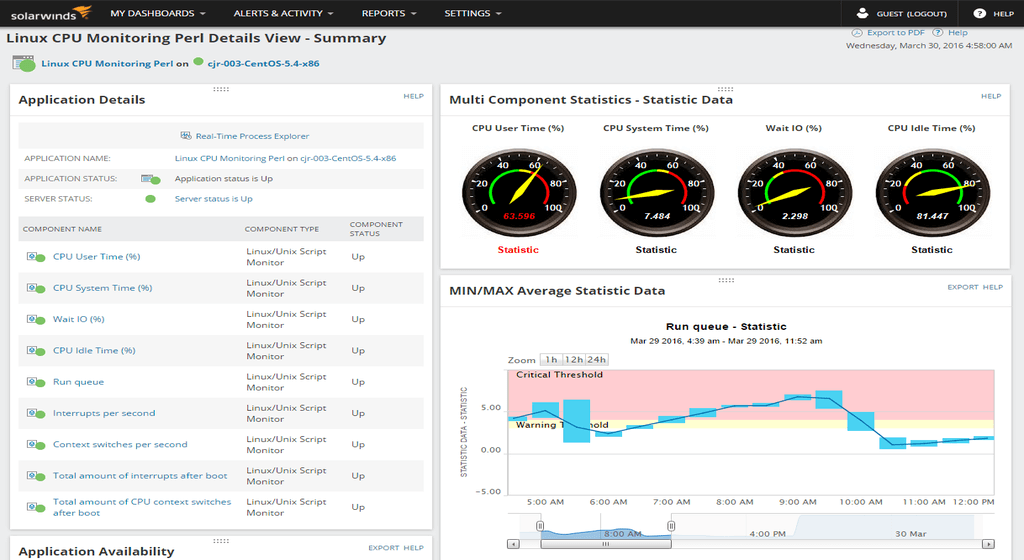What should I monitor on Linux?
Summary of the Article: How to Monitor Linux OS
To monitor Linux server performance, you’ll need to install a node exporter utility that collects multiple hardware-related and kernel-related metrics (CPU, disk utilization, memory, network statistics, etc.), then makes them available to the Prometheus server to scrape.
1. How do I monitor Linux OS?
To monitor Linux server performance, you’ll need to install a node exporter utility that collects multiple hardware-related and kernel-related metrics (CPU, disk utilization, memory, network statistics, etc.), then makes them available to the Prometheus server to scrape.
2. Which method would you prefer while monitoring a Linux machine?
Another common method of monitoring remote Linux/Unix hosts is to use the NRPE addon. NRPE allows you to execute plugins on remote Linux/Unix hosts. This is useful if you need to monitor local resources/attributes like disk usage, CPU load, memory usage, etc. on a remote host.
3. How to check CPU health in Linux?
The sar tool is a utility for managing system resources. It’s not limited strictly to CPU usage, but you can use the -u option to track CPU performance. The –u option tells it to display CPU usage. The 5 indicates that it should display every 5 seconds.
4. How do I monitor and manage processes in Linux?
In Linux, Top command is utilized to monitor Linux Process which is used frequently used by many systems. It is available under many Linux, Unix-like operating systems. All the running and active real-time processes in the ordered list are displayed and updates it regularly by this Top command.
5. How do I monitor my CPU and RAM in Linux?
Open a terminal. Use the cat command to display the data held in /proc/cpuinfo. This command will produce a lot of text, typically it will repeat the same information for the number of cores present in your CPU. A more concise means to get most of this information is via lscpu, a command that lists the CPU details.
6. How to check hardware health in Linux?
vmstat is a Unix/Linux command that displays the status of the virtual memory kernel plus some other useful system statistics. It can be run by typing ‘vmstat 5’ which will display one line of data every 5 seconds until it is canceled.
7. Why should we monitor processes in Linux?
Processes need to be managed and monitored because they consume system resources like CPU time, memory, and disk space.
8. How do I monitor processes in real-time in Linux?
You can list running processes using the ps command (ps means process status). The ps command displays your currently running processes in real-time.
9. How to check RAM and CPU in Linux?
Open a terminal. Use the cat command to display the data held in /proc/cpuinfo. This command will produce a lot of text, typically it will repeat the same information for the number of cores present in your CPU. A more concise means to get most of this information is via lscpu, a command that lists the CPU details.
10. How to check CPU bottleneck in Linux?
Use the following tools to identify system bottlenecks on UNIX: top. View overall system performance. iostat. Monitor the loading operation for every disk attached to the database server. vmstat. Monitor disk swapping actions. sar. View detailed system activity reports of CPU, memory, and disk usage.
11. How to check GPU in Linux?
Checking GPU Information in Ubuntu. Once the terminal is open, type in the command “lspci” and press enter. This will display a list of all the PCI devices connected to your computer. Look for the 

How do I monitor Linux OS
To monitor Linux server performance, you'll need to install a node exporter utility that collects multiple hardware-related and kernel-related metrics (CPU, disk utilization, memory, network statistics, etc.), then makes them available to the Prometheus server to scrape.
Cached
Which method would you prefer while monitoring a Linux machine
Another common method of monitoring remote Linux/Unix hosts is to use the NRPE addon. NRPE allows you to execute plugins on remote Linux/Unix hosts. This is useful if you need to monitor local resources/attributes like disk usage, CPU load, memory usage, etc. on a remote host.
How to check CPU health in Linux
sar Command to Show CPU Utilization
The sar tool is a utility for managing system resources. It's not limited strictly to CPU usage, but you can use the -u option to track CPU performance. The –u option tells it to display CPU usage. The 5 indicates that it should display every 5 seconds.
How do I monitor and manage processes in Linux
In Linux, Top command is utilized to monitor Linux Process which is used frequently used by many systems. It is available under many Linux, Unix like operating system. All the running and active real-time processes in ordered list is displayed and updates it regularly by this Top command.
How do I monitor my CPU and RAM in Linux
Open a terminal.
2. Use the cat command to display the data held in /proc/cpuinfo. This command will produce a lot of text, typically it will repeat the same information for the number of cores present in your CPU. A more concise means to get most of this information is via lscpu, a command that lists the CPU details.
How to check hardware health in Linux
vmstat is a Unix/Linux command that displays the status of the virtual memory kernel plus some other useful system statistics. It can be run by typing 'vmstat 5 ' which will display one line of data every 5 seconds until it is canceled.
Why should we monitor processes in Linux
Processes need to be managed and monitored because they consume system resources like CPU time, memory and disk space.
How do I monitor processes in real-time in Linux
You can list running processes using the ps command (ps means process status). The ps command displays your currently running processes in real-time.
How to check RAM and CPU in Linux
Open a terminal.
2. Use the cat command to display the data held in /proc/cpuinfo. This command will produce a lot of text, typically it will repeat the same information for the number of cores present in your CPU. A more concise means to get most of this information is via lscpu, a command that lists the CPU details.
How to check CPU bottleneck in Linux
Use the following tools to identify system bottlenecks on UNIX:top. View overall system performance.iostat. Monitor the loading operation for every disk attached to the database server.vmstat. Monitor disk swapping actions.sar. View detailed system activity reports of CPU, memory, and disk usage.
How to check GPU in Linux
Checking GPU Information in Ubuntu
Once the terminal is open, type in the command “lspci” and press enter. This will display a list of all the PCI devices connected to your computer. Look for the line that says “VGA compatible controller” and note the name of the device. This is the name of your graphics card.
How to check RAM performance in Linux
Linux check ram speed and type commandsOpen the terminal application or log in using ssh command.Type the “ sudo dmidecode –type 17 ” command.Look out for “Type:” line in the output for ram type and “Speed:” for ram speed.
How to check hardware performance in Linux
Top 7 Linux performance commands for system administratorstop.vmstat.lsof.tcpdump.netstat.iostat.iotop.
What is performance monitoring in Linux
Monitor and measure critical metrics like CPU, memory, disk utilization, processes, and network traffic of Linux servers from a unified dashboard.
How do I manage processes in Linux
Commands Used to Manage Processes in Linuxps: This command is used to display information about running processes.top: This command is used to display a real-time view of system processes.kill: This command is used to terminate a process.nice: This command is used to adjust the priority of a process.
How do I monitor running processes
All operating systems include a utility that shows current processes. In Windows, this utility is the Task Manager. To get it, right-click on the Taskbar and select Task Manager from the pop-up menu that appears. This utility list all processes in categories.
What are real-time tasks in Linux
Real-time tasks are executed by the real-time kernel, and normal Linux programs are allowed to run when no real- time tasks have to be executed. Linux can be considered as the idle task of the real-time scheduler. When this idle task runs, it executes its own scheduler and schedules the normal Linux processes.
How do I check my CPU and RAM performance
Press Ctrl + Shift + Esc to launch Task Manager. Or, right-click the Taskbar and select Task Manager. Select the Performance tab and click Memory in the left panel. The Memory window lets you see your current RAM usage, check RAM speed, and view other memory hardware specifications.
How do you check top 5 CPU consuming process in Linux
Use ps Command to Find Top Processes by Memory and CPU Usage
ps is a Linux command-line utility with many options that helps you to display output in different formats. You can use the ps command with –sort argument to sort the output by memory and CPU usage.
How to check performance issue in Linux
Top 7 Linux performance commands for system administratorstop.vmstat.lsof.tcpdump.netstat.iostat.iotop.
How to test GPU performance in Linux
glmark2 – Stress-testing GPU performance on Linux.glxgears – Simple Linux GPU performance testing tool.gpustat – A simple tool to get Nvidia GPU stats on Linux and FreeBSD Unix.intel_gpu_top – Displying a top-like summary of Intel GPU usage on Linux.nvidia-smi – NVIDIA System Management Interface program.
How do I monitor my GPU usage
To monitor the overall GPU resource usage, click the Performance tab, scroll down the left pane, and find the “GPU” option. Here you can watch real-time usage. It displays different graphs for what is happening with your system — like encoding videos or gameplay.
How do I check my RAM efficiency
Press Ctrl + Shift + Esc to launch Task Manager. Or, right-click the Taskbar and select Task Manager. Select the Performance tab and click Memory in the left panel. The Memory window lets you see your current RAM usage, check RAM speed, and view other memory hardware specifications.
How do I optimize Linux performance
In general, to scale CPU usage on a Linux system you should:Increase the number of CPU cores to improve the clock speed.Optimize the use of the CPU cache.Use a CPU architecture that is well-suited to the workload.Carefully manage the operating system's scheduling policies.
How do I stop unnecessary processes in Linux
The kill Command. The basic command used to kill a process in Linux is kill. This command works in conjunction with the ID of the process – or PID – we want to end.



